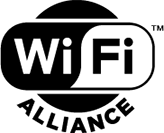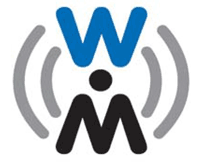
IEEE 802.11 is part of the IEEE 802 set of LAN protocols, and specifies the set of media access control (MAC) and physical layer (PHY) protocols for implementing wireless local area network (WLAN) Wi-Fi computer communication in various frequencies, including but not limited to 2.4 GHz, 5 GHz, and 60 GHz frequency bands.

Wi-Fi is a family of wireless networking technologies, based on the IEEE 802.11 family of standards, which are commonly used for local area networking of devices and Internet access. Wi‑Fi is a trademark of the non-profit Wi-Fi Alliance, which restricts the use of the term Wi-Fi Certified to products that successfully complete interoperability certification testing. As of 2010, the Wi-Fi Alliance consisted of more than 375 companies from around the world. As of 2009, Wi-Fi-integrated circuit chips shipped approximately 580 million units yearly. Devices that can use Wi-Fi technologies include desktops and laptops, smartphones and tablets, smart TVs, printers, digital audio players, digital cameras, cars and drones.

Wi-Fi Alliance is a non-profit organization that promotes Wi-Fi technology and certifies Wi-Fi products for conformity to certain standards of interoperability. Not every IEEE 802.11-compliant device is submitted for certification to the Wi-Fi Alliance, sometimes because of costs associated with the certification process. The lack of the Wi-Fi logo does not necessarily imply a device is incompatible with Wi-Fi devices.

Wireless USB is a short-range, high-bandwidth wireless radio communication protocol created by the Wireless USB Promoter Group which intends to further increase the availability of general USB-based technologies. In large, IPv6 was a key of this technology. It is maintained by the WiMedia Alliance and the current revision is 1.0, which was approved in 2005. Wireless USB is sometimes abbreviated as "WUSB", although the USB Implementers Forum discouraged this practice and instead prefers to call the technology Certified Wireless USB to distinguish it from the competing UWB standard.

DisplayPort (DP) is a digital display interface developed by a consortium of PC and chip manufacturers and standardized by the Video Electronics Standards Association (VESA). The interface is primarily used to connect a video source to a display device such as a computer monitor, and it can also carry audio, USB, and other forms of data.
IEEE 802.11n-2009, commonly shortened to 802.11n, is a wireless-networking standard that uses multiple antennas to increase data rates. The Wi-Fi Alliance has also retroactively labelled the technology for the standard as Wi-Fi 4. It standardized support for multiple-input multiple-output, frame aggregation, and security improvements, among other features, and can be used in the 2.4 GHz or 5 GHz frequency bands.

The WiMedia Alliance was a non-profit industry trade group that promoted the adoption, regulation, standardization and multi-vendor interoperability of ultra-wideband (UWB) technologies. It existed from about 2002 through 2009.
WirelessHD, also known as UltraGig, is a proprietary standard owned by Silicon Image for wireless transmission of high-definition video content for consumer electronics products. The consortium currently has over 40 adopters; key members behind the specification include Broadcom, Intel, LG, Panasonic, NEC, Samsung, SiBEAM, Sony, Philips and Toshiba. The founders intend the technology to be used for Consumer Electronic devices, PCs, and portable devices.
IEEE 802.11 – or more correctly IEEE 802.11-1997 or IEEE 802.11-1999 – refer to the original version of the IEEE 802.11 wireless networking standard released in 1997 and clarified in 1999. Most of the protocols described by this early version are rarely used today.
IEEE 802.11b-1999 or 802.11b, is an amendment to the IEEE 802.11 wireless networking specification that extends throughput up to 11 Mbit/s using the same 2.4GHz band. A related amendment was incorporated into the IEEE 802.11-2007 standard.
IEEE 802.11g-2003 or 802.11g is an amendment to the IEEE 802.11 specification that operates in the 2.4 GHz microwave band. The standard has extended throughput to up to 54 Mbit/s using the same 20MHz bandwidth as 802.11b uses to achieve 11 Mbit/s. This specification under the marketing name of Wi-Fi has been implemented all over the world. The 802.11g protocol is now Clause 19 of the published IEEE 802.11-2007 standard, and Clause 19 of the published IEEE 802.11-2012 standard.
Gi-Fi or gigabit wireless refers to a wireless communication at a data rate of more than one billion bits (gigabit) per second.
Wireless HDMI is a colloquial term for wireless high-definition audio and video signals connectivity on consumer electronics products.
Wireless Home Digital Interface (WHDI) is a consumer electronic specification for a wireless HDTV connectivity throughout the home.
WiGig, alternatively known as 60GHz Wi-Fi, refers to a set of 60 GHz wireless network protocols. It includes the current IEEE 802.11ad standard and also the upcoming IEEE 802.11ay standard.
Wilocity was a fabless semiconductor company based in California founded in 2007 developing 60 GHz multi-gigabit wireless chipsets for both the mobile computing platform and peripheral markets. Wilocity was founded in March 2007 by executives and engineers from Intel's Wi-Fi Centrino group. While Wilocity is based in California, most of its employees are in Israel. Based on the WiGig specification, Wilocity's Wireless PCI Express (wPCIe) technology enables multi-gigabit wireless for applications including I/O, networking and video.
IEEE 802.11ac is a wireless networking standard in the 802.11 set of protocols, providing high-throughput wireless local area networks (WLANs) on the 5 GHz band. The standard was developed in the IEEE Standards Association from 2008 through 2013 and published in December 2013. The standard has been retroactively labelled as Wi-Fi 5 by Wi-Fi Alliance.

Wireless Display (WiDi) was technology developed by Intel that enabled users to stream music, movies, photos, videos and apps without wires from a compatible computer to a compatible HDTV or through the use of an adapter with other HDTVs or monitors. Intel WiDi supported HD 1080p video quality, 5.1 surround sound, and low latency for interacting with applications sent to the TV from a PC.
IEEE 802.11ad is an amendment to the IEEE 802.11 wireless networking standard, developed to provide a Multiple Gigabit Wireless System (MGWS) standard at 60 GHz frequency, and is a networking standard for WiGig networks. Because it uses the V band of millimeter wave (mmW) frequency, the range of IEEE 802.11ad communication would be rather limited compared to other conventional Wi-Fi systems. However, the high frequency allows it to use more bandwidth which in turn enables the transmission of data at high data rates up to multiple gigabits per second, enabling usage scenarios like transmission of uncompressed UHD video over the wireless network.
IEEE 802.11ah is a wireless networking protocol published in 2017 to be called Wi-Fi HaLow as an amendment of the IEEE 802.11-2007 wireless networking standard. It uses 900 MHz license exempt bands to provide extended range Wi-Fi networks, compared to conventional Wi-Fi networks operating in the 2.4 GHz and 5 GHz bands. It also benefits from lower energy consumption, allowing the creation of large groups of stations or sensors that cooperate to share signals, supporting the concept of the Internet of Things (IoT). The protocol's low power consumption competes with Bluetooth and has the added benefit of higher data rates and wider coverage range.






